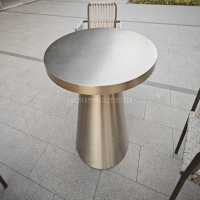Welcome to the website for landscape facilities products and knowledge.
How does the table’s design support the use of personal or team breathwork or pranayama tools?
In the evolving landscape of wellness practices, the design of furniture plays a crucial yet often overlooked role in supporting breathwork and pranayama techniques. Modern tables specifically crafted for these purposes integrate multiple design elements that directly enhance both personal meditation and group sessions.
The surface area of a breathwork table is intentionally calibrated to accommodate various pranayama tools without creating clutter. Unlike conventional tables, these designs feature measured dimensions that allow practitioners to arrange singing bowls, breathing resistance devices, essential oil diffusers, and meditation timers within natural reach. This spatial consideration prevents unnecessary movement during sessions, maintaining focus and rhythmic breathing patterns.
Ergonomic height represents another critical design factor. Tables designed for seated breathwork position the surface at precisely calculated levels that promote spinal alignment while allowing relaxed arm placement. This vertical calculation varies for floor-sitting versus chair-based practices, with adjustable models offering versatility for different body types and meditation styles. The elimination of hunching or reaching preserves diaphragmatic freedom, essential for deep pranayama exercises.
Integrated storage solutions transform these tables into organized wellness stations. Discrete compartments beneath the surface securely hold resistance breathing trainers, nasal cleansing pots, and instructional materials. This organizational capacity proves particularly valuable for team breathwork sessions where multiple practitioners require efficient access to shared tools while maintaining a tranquil environment.
Material selection consciously impacts the sensory experience of breathwork. Natural wood surfaces provide organic warmth and vibration conductivity, enhancing the resonance of singing bowls and tuning forks. Non-porous stone tops offer coolness that some traditions associate with calming energy, while cork inserts provide sound-dampening qualities for moving tools quietly during meditation.
Several designs incorporate subtle guidance elements directly into the table surface. Etched breathing rhythm patterns serve as visual metronomes for synchronized team sessions, while measured distance markers help practitioners position tools at optimal focal lengths. These integrated guides support both beginners establishing practice fundamentals and experienced guides leading group sessions.
The mobility aspect of certain breathwork tables addresses the evolving nature of practice spaces. Lightweight materials and carefully balanced structures allow easy repositioning to capture optimal lighting or accommodate fluctuating group sizes. Locking casters provide stability during intense breathing exercises while permitting rapid room reconfiguration.
For team practices, modular table systems create adaptable configurations. Interlocking units form circular arrangements that facilitate shared energy flow, while linear setups support instructional formats. This flexibility enables facilitators to customize spatial dynamics based on group size and practice intensity, from gentle coherent breathing to more vigorous holotropic-style sessions.
Advanced models now incorporate technology interfaces that remain discreetly hidden during traditional practice. Wireless charging surfaces power digital breath pacers, while integrated cable management maintains clear space for movement. These technological accommodations acknowledge the growing synergy between ancient techniques and modern biofeedback devices.
The psychological impact of dedicated breathwork furniture shouldn't be underestimated. A purpose-designed table creates a psychological anchor that signals transition into practice mode, helping practitioners shift more rapidly into meditative states. This conditioned response enhances both personal consistency and group synchrony, making the table itself an integral tool in the breathwork ecosystem.
As breathwork continues gaining recognition for its therapeutic benefits, the furniture supporting it evolves correspondingly. The most effective table designs don't merely hold tools—they actively participate in the practice by promoting proper posture, ensuring tool accessibility, and creating an environment conducive to respiratory awareness and control.
Related search:

Recommendation
Outdoor Metal Table - Classic Outdoor Furniture, Stainless Steel Table, Durable and Reliable